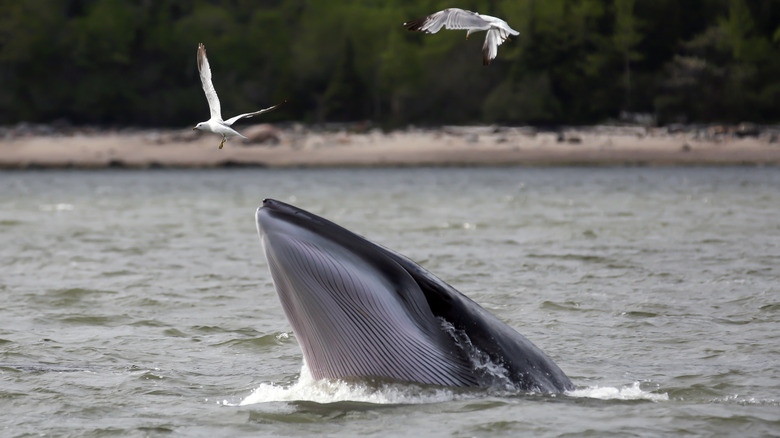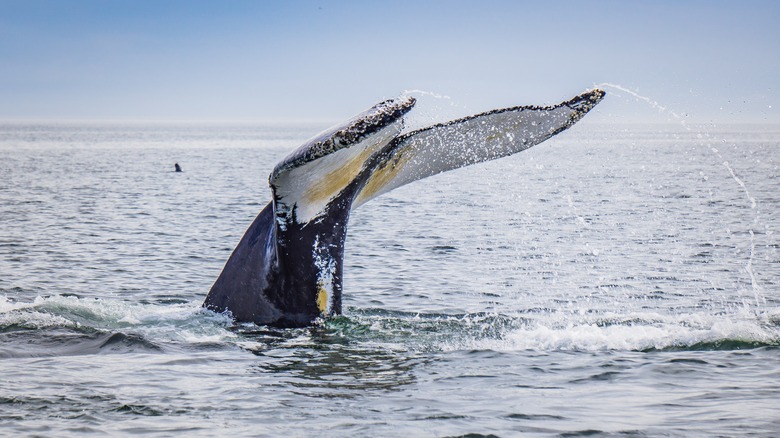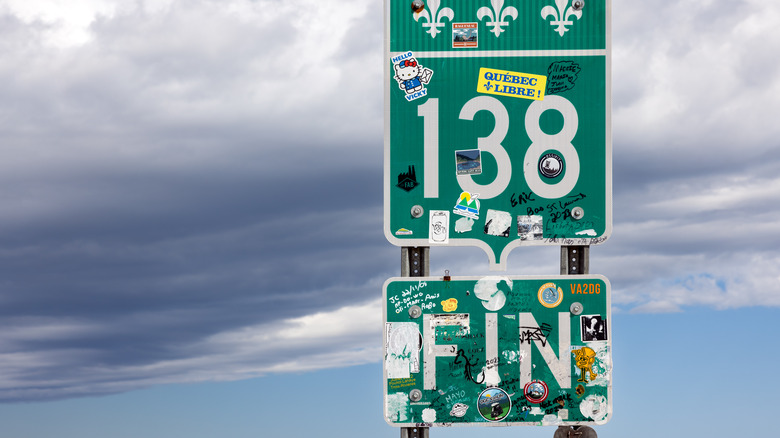A Road Along Quebec's Breathtaking Coast Is One Of The Best Whale-Watching Destinations
Head northeast out of Montreal, following the Estuary of St. Lawrence, and you're almost guaranteed to spot a whale spout or the cheeky flip of a fin. This breathtaking coastal road, better known as Route 138, offers wildlife and nature lovers a gleeful ride into the heart of the Quebecois wilderness and into the Côte Nord region, a little-known area on Canada's coastline.
Route 138 is over 800 miles long, a highway that begins just south of Montreal and winds its way along the St. Lawrence River, and eventually the estuary, to the remote Côte Nord village of Kegaska. Cetaceans of all shapes and sizes flock to these waters in Quebec's summer months, looking to dine on a smorgasbord of krill. While a variety of whales, dolphins, and porpoises come to this area of Canada for their summer vacation, including humpback, minke, and blue whales, they stay for the beginning of fall too before heading back to the Caribbean for the winter. In total, 13 different species of whales make their way to this area every year!
Affectionately referred to as the "Whale Route" and "Les Route des Baleines" in French, you'll also come across plenty of dedicated observation points along the way. In fact, you can see whales right from the shoreline along this rural highway, without ever needing to risk seasickness on a whale-watching tour. Whether you're a wildlife lover in search of the world's largest creatures or you simply love being out in nature and exploring off-the-beaten-path, this is the ideal Canadian road trip!
The best time to see whales in Quebec
While you might think you need to seek out tropical island destinations for whale-watching, the coast of Quebec is one of the best places in the world to see these gentle giants. Whale-watching season in Quebec begins in May and runs until freezing temperatures begin to set in around November. Sightings are rare in May and the beginning of June with July to mid-October being the peak season. Considering that the Saint Lawrence Estuary is one of the best places in the province to spot whales due to its unusually deep channels and abundance of krill, your chances are good in season and can even extend beyond November if you're lucky.
For visitors who are planning on hopping on a whale-watching tour, your best bet weather-wise is from August to early October. Early in the season fog can be an issue while later in the season, the weather can turn windy and cold. Although you can simply follow Route 138 and have a chance of seeing whales from the shoreline, seeking out the whales and dolphins via kodiak or kayak is a one-of-a-kind experience. There's also a chance you'll spot other Canadian wildlife along the way, including seals, black bears, moose, and caribou. Like the whales, Atlantic puffins also migrate to the rocky cliffs of Quebec by summer and can be spotted on the Mingan Archipelago near Sept-Îles.
What to do along Route 138 in Quebec
Kicking off your trip in the beautiful city of Montreal with its charming Paris vibes is a great way to start Route 138. That being said, the first place along the way that you'll be able to spot whales is in Tadoussac, about six hours north. This is where the St. Lawrence River meets the Saguenay Fjord. The best spot here to keep your eyes peeled for a spout or tail flap is on the Pointe de l'Islet Trail. This loop hike circumnavigates a small peninsula at the mouth of the Saguenay Fjord. Another fun stop in the area where visitors can learn more about Quebec's cetaceans is the Marine Mammal Interpretation Center, located just before the parking lot of the trail. Ask the visitor desk for their Weekly Sightings Map to see where the whales have recently been hanging out.
As you continue making your way north, you'll find plenty of observation points to stop at and breathtaking landscapes to take in too. Cap de Bon Desir is another good stop and also includes a historic lighthouse and an interpretation center with information about local marine life. Continue up to the Pointe-des-Monts Lighthouse and its candy cane facade, where you'll have another chance to spot a whale or two before popping into the town of Sept-Îles with its harbor and scattered islands (hence the town name). Further north, the Mingan Archipelago is another hotspot for whales before the end of the line in Kegaska.


